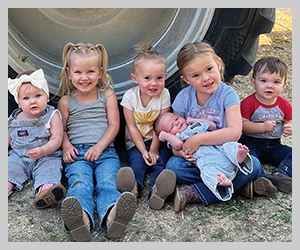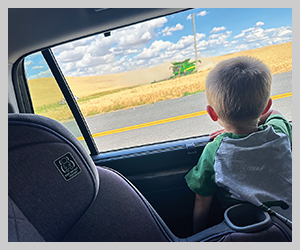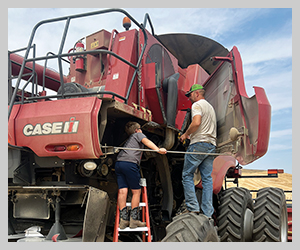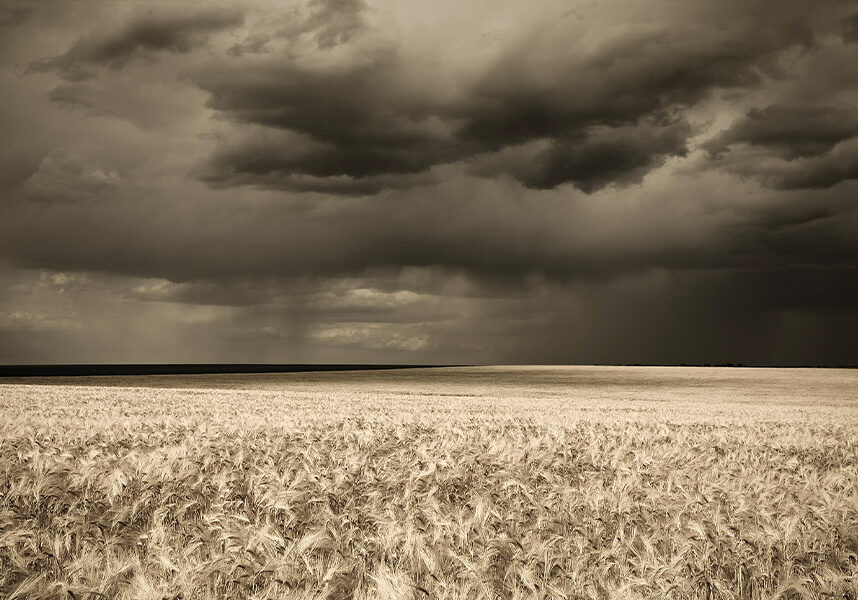
To be Ukrainian today is a huge challenge. It is a pain, but it is also a pride. The war in Ukraine has affected each Ukrainian family and even everybody around the world. I am pleased to share with you my survival story and tell about Ukraine first hand. I would never have thought that my children and I would become refugees, and I would find a shelter in Manhattan, Kan.
My educational background is in agricultural economics. I made a successful career in university education. My last position before the Russian-Ukrainian war started was dean of faculty of economics and entrepreneurship at the Vinnytsia National Agrarian University. After a few days of Russian invasion and several bombings in Vinnytsia, my husband and I decided that I needed to go with our two children to a safer place, and Manhattan, Kan., became that safe place for us. Like thousands of other refugees, we crossed the border into Poland on foot. Polish people helped us with housing, food and all necessities before we flew to the U.S. My husband stayed in Ukraine to defend our country. It is a tough breakup, but here I have very nice friends who support our family, and who don’t let me feel alone.
I had been to Kansas State University (KSU) during the 2004-05 academic year as a visiting professor within the Fulbright/Junior Faculty Development Program held by the U.S. Department of State. My mentors were Barry Flinchbaugh and Dan Bernardo. The goal of my scholarship was to learn features of higher education in a sphere of agricultural economics at K-State and to conduct research on agricultural extension development in order to implement the best American practices in Ukraine. One of the important missions was also cultural and scientific exchange. I made a lot of great relationships with KSU representatives, so it was no doubt that I needed to return “home” in Kansas. I appreciate very much all their support and warm welcoming.
Agricultural land in Ukraine
Being here previously and doing research, I have found a lot of similarities between Kansas and my country. Ukraine is roughly three times larger than Kansas. Like Kansas, Ukraine’s economy is based on agriculture. We both have significant crops of wheat, corn and sunflowers.
Ukraine is endowed with the largest areas of agricultural land and the most fertile soils in Europe and the world. Agricultural land accounts for 42.7 million hectares (105.5 million acres), which is 70.8 percent of the total area of the country (60 million ha or 148.3 million acres). Of these, 33 million ha (81.5 million acres) are in tillage, compared with 21.5 million acres of arable land in Kansas, 18 million ha (44.5 million acres) in France, 12 million ha (29.6 million acres) in Germany and 11 million ha (27.2 million acres) in Poland.
Ukraine also owns a third of the world’s black soils stock, a very fertile soil that can produce high yields under good economic conditions. In addition, Ukraine is endowed with a strategic location with access to agricultural markets in Europe, the Middle East and North Africa through Black Sea ports. All these factors — under appropriate use of agricultural potential — were making Ukraine an important player on the agri-food world market and provided possibilities for economic growth and improved living standards for the population.
Land ownership in Ukraine
Before Ukraine was forcibly incorporated into the Soviet Union, it was an independent country with a large number of private agricultural producers. During Soviet-imposed collectivization, all lands and farm animals were taken away from them, and a number of state collective farms were established. We remember the horrors of the “Holodomor” very well, when Soviet authorities took all the grain from the Ukrainians in order to destroy the nation by starving people to death.
After Ukraine gained independence from the USSR, land reform was started. The state monopoly on land was abolished by a resolution of the Ukrainian Verkhovna Rada (Supreme Council of Ukraine) in March 1991. Verkhovna Rada transferred property rights and disposal of agricultural land from traditional Soviet collective and state farms to the collective ownership of business entities created on their basis — collective agricultural enterprises (CAP).
As a result, in January 1993, 99.5 percent of the more than 11,000 СAPs received collective ownership of 27.6 million ha of agricultural land. In the fall of 1994, the privatization of the agricultural land of the CAP among their members began. Each participant of the CAP was given a land share (in conditional cadastral hectares without specifying location), which was confirmed by an appropriate certificate for the right of private ownership of the land share. The portion of land that was granted averaged 3.6 ha, depending on the size of the collective agricultural enterprise and the number of its members. The owners of such plots of land received the right to dispose, physically define the area and own it. As a result, 6.92 million rural residents (about 16 percent of the total population) received certificates on the right of private ownership of land.
The distribution of land shares was constrained by the slow process of restructuring the CAP into new forms of agricultural enterprises. As of March 2000, almost all CAPs changed their status to new forms of agricultural enterprises defined by law (private personal farms, agricultural cooperatives, limited liability companies, private enterprises, etc.). Currently, almost all landowners have turned their certificates for the right of private ownership of a land share into legal acts for land, thus becoming owners of land plots with a certain location and not just virtual. But in 2002, the Verkhovna Rada of Ukraine adopted a new Land Code of Ukraine, which introduced a moratorium on the sale/purchase of 38.5 million hectares of agricultural land (66 percent of the entire territory of Ukraine). The goal of the moratorium was to prevent consolidation of large areas of the agricultural land in the hands of oligarchs and transnational companies.
Since 2019, land reform has gained new impulse and has been deployed on an unprecedented scale. Thanks to the Law on the Turnover of Agricultural Land (No. 552-IX of March 31, 2020), a general model of the land market was determined, which was supposed to work from July 1, 2021. Unfortunately, because of the Russian invasion, the land reform was not conducted to the very end. A transparent, fair and efficient market of agricultural land was supposed to create conditions for the release of the agricultural potential of the country and the rural economy, increasing economic growth by 0.5-1.5 percent annually over a five-year period.
Current Russian invasion is a continuation of implementation of the Soviet dominating ambitions. It is a Holocaust of Ukrainian nation — a frightening echo of the Holodomor.
Economy, ag production and exports
In order to better understand the reason (for the Soviet invasion), let’s analyze some important economic data that represents the place of Ukraine in the world economy, especially in global grain markets. According to the State Statistics Service of Ukraine, in 2021, the country produced 32.72 million metric tons (1.2 billion bushels) of wheat. That is 129.4 percent compared to 2020. The harvested area was 7.1 million ha (17.43 million acres). The total volume of corn production is Ukraine in 2021 was 39.82 million metric tons (1.57 billion bushels). That is 141.9 percent compared to the previous year. These dramatic gains reflect a continuation of a trend over several years in increased yield per hectare, which amounted to 30-40 percent in 2021 compared to the previous year. These increases reflect continuously improved agronomic practices, which the war seems likely to bring to an end.
Ukraine is a top producer and exporter of sunflower seeds. Ukraine had the highest production of sunflower seeds in the world in the 2021/22 crop year. During that time period, Ukraine produced around 17.5 million metric tons of sunflower seeds. Russia was the second producer of sunflower seeds worldwide, with a production volume of 15.5 million metric tons in 2021/22.
According to the results of 2021, grain exports from Ukraine amounted to 51.2 million tons, worth $12.5 billion, which is almost the same as shipments in 2020 in physical terms, but 31 percent more in cash. The increase in grain export revenues was facilitated by the upward trend in the dynamics of prices for the main grain crops in Ukraine. Thus, the average export supply prices for wheat 12.5 percent at the FOB site at the end of December 2021 compared to the beginning of January 2021 increased by 25 percent, barley by 34 percent and corn by 17 percent. Wheat exports in 2021 amounted to 20.1 million tons (738.5 million bushels), exceeding the figure a year earlier by 11 percent. Turkey has seen the largest increase in Ukrainian grain imports (1.8 million tons, 76 percent by the end of 2020).
The share of Ukrainian wheat exports in global export for the last few years was 12 percent, corn was 16 percent, and it is in 4th place in the world. Russia’s share was up to 16 percent in wheat and only 2 percent in corn.
Exports of corn from Ukraine to foreign markets in 2021 compared to 2020 decreased by 12 percent — from 28 million to 24.7 million tons. At the same time, the largest decrease in corn purchases was observed by the Republic of Korea (437.4 thousand tons, a 67 percent decrease by 2020), and an increase by Iran (1.7 million tons, 37 percent by 2020).
As a result of the 2021 season, Ukraine exported 6.1 million tons of vegetable oils, among those 5.75 million tons of sunflower oil. Most of the product was exported to the EU — 32 percent; India — 32.5 percent; and China — 15.3 percent. The share of Ukrainian sunflower oil in the world export for the last two years was 47 percent. In 2021, Ukraine and Russia controlled 77 percent of global oil exports.
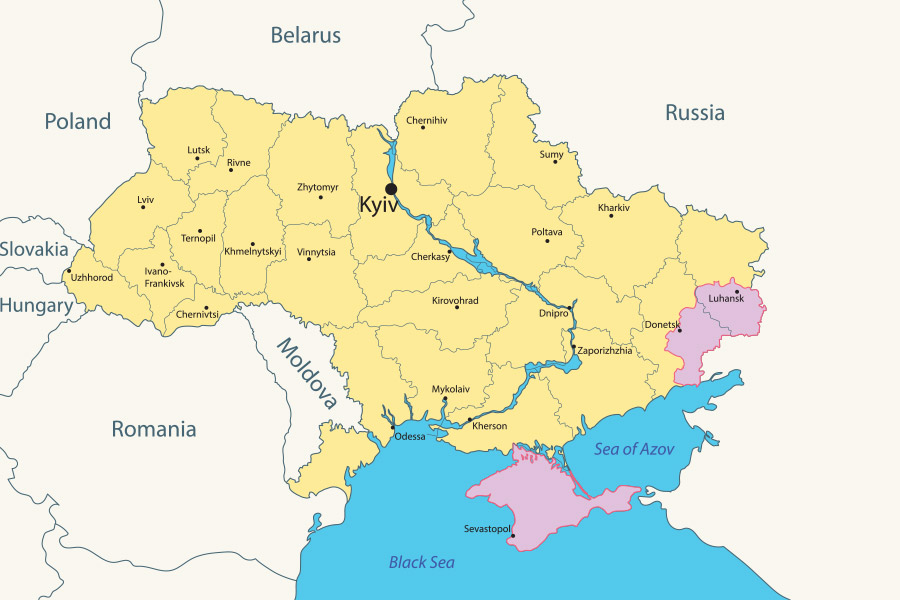
Objective of Russian invasion
So, we can safely state the fact that Ukraine is a significant player in global grain markets. Consequently, one of the reasons for the Russian invasion into Ukraine is obvious: Russia wants to appropriate our rich land, to establish control over the export of grain and other trade to Europe and other countries, including through the seizure of seaports, in order to continue to blackmail the world with its monopolistic position, not only in the fuel market, but also in the issue of food security.
The Russian-Ukrainian war will make a significant impact on the global wheat market. But now it is very difficult to predict all the losses without knowing how many people (labor) left Ukraine or suffered, how many infrastructure facilities were wrecked, how many hectares of agricultural land/crops were destroyed or occupied, and if Ukraine will be able to plant/harvest, etc.
Planting spring crops
Currently, due to the war in Ukraine, farmers cannot start planting on an area of 3.5 million ha of agricultural land, says Mykola Solsky, minister of agrarian policy and food of Ukraine. As of April 1, spring crops planting in Ukraine for the country’s 2022 crop is projected to be conducted on 13.44 million ha of controlled territory. As for now, spring crops planted on 603 thousand ha, among them wheat — 81 thousand ha (43.6 percent compared to previous year harvested area), barley — 327 thousand ha (24.5 percent), and sunflower — 33.7 thousand ha (0.5 percent).
According to preliminary estimations, only 4.7 million ha will be planted with spring grains in Ukraine in 2022, which is 39 percent less than in the previous season. The situation is also aggravated by the disruption of resource supply chains, which will affect both the size of the cultivated area and future yields. An important factor is the impossibility of obtaining seed material ordered by farmers earlier, and, in many cases, even paid for. This, most likely, will lead to an additional reduction in corn crops. The corn planting campaign is under risk. Unlike wheat, the corn crop is not yet planted at all, and some key regions are under the heaviest attacks from Russian troops (Kharkiv, Chernihiv, Poltava and other regions).
Harvesting winter crops
The situation is also extremely negative for winter crops. Taking into account the current map of military activity, according to estimates, out of 7.6 million ha of winter wheat, rye and barley sown, only 5.5 million hectares may be available for harvesting. That corresponds to a 28 percent loss of area. The future availability of fuel, fertilizer, machinery and labor will have a significant impact on the planting/harvesting campaigns’ continuation. Therefore, estimates will be repeatedly changed in accordance with the development of hostilities in the territory of Ukraine.
Blockade of Ukrainian ports
The blockade of Ukrainian seaports also brings significant losses to the national and world economies. According to the interview of Denis Shmygal, prime minister of Ukraine, almost 90 percent of grain accumulated as of early April in granaries, elevators and warehouses cannot be exported due to the blockade of Ukrainian ports. And the export of existing surpluses would give Ukraine $7-$10 billion. During March 2022, it was reported Ukraine exported just 1.1 million tons of corn, 309 thousand tons of wheat, 118 thousand tons of sunflower oil and 40 thousand tons of soybeans. This is four times less than in February 2022. It is unclear whether the vessels loaded in March were able to depart for their destinations because of the blockade of the ports. The Ukrainian and Polish ministers of agriculture recently discussed issues related to the establishment of uninterrupted overland supplies of agri-food products from Ukraine to traditional export-dependent markets and the search for alternative ways to deliver through EU transit corridors.
Long-term impact
The Russian-Ukrainian war will have a long-term impact on the world market and will lead to a repartition of the market share of players, the formation of new supply chains, and changes in the pricing mechanism. To maintain its leading position in the grain market and ensure its own food security, Ukraine needs global support for the supply of fuel, seeds, fertilizers and the creation of safe export-import corridors. But above all, Ukraine needs peace.
At the same time, other countries, such as the U.S., which are powerful producers of grain in particular, should assess their potential for increasing their production and exports in order to protect import-dependent countries from a future food crisis. There are many uncertainties, and I will be constantly monitoring news and reports about several major factors:
- Size of current grain stores.
- Fate and distribution of grain stores.
- Availability of farm labor and crop inputs.
- Planting/harvesting situation.
- Volume of production and effect on grain supply.
Thank you to my friends and the welcoming gestures of Kansans during this moment in time that has changed my family’s lives forever.





